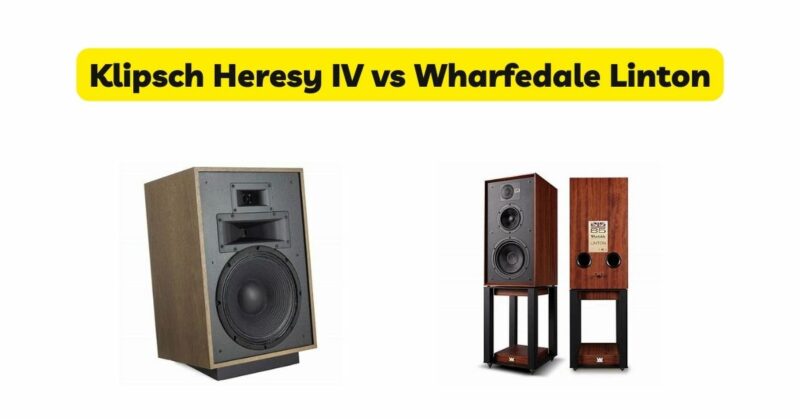When it comes to high-quality speakers, two brands that stand out are Klipsch and Wharfedale. Both companies have a long history of producing exceptional audio equipment, and their models, Klipsch Heresy IV and Wharfedale Linton, have gained significant popularity among audiophiles. In this article, we will compare these two iconic speakers, delving into their design, sound performance, features, and overall value. By the end, you’ll have a better understanding of which speaker might suit your listening preferences and needs.
Design and Build
The Klipsch Heresy IV and the Wharfedale Linton exhibit distinct design aesthetics that reflect the brands’ respective philosophies. The Heresy IV follows Klipsch’s timeless design principles, featuring a classic boxy enclosure with a front-firing woofer, horn-loaded midrange, and tweeter. The speaker’s retro appearance, available in a range of wood veneer finishes, appeals to vintage enthusiasts.In contrast, the Wharfedale Linton embraces a more traditional speaker cabinet design. Its vintage-inspired look includes a larger rectangular enclosure with rounded edges, available in multiple finishes, including walnut and black ash. The Linton’s design captures a nostalgic feel while blending seamlessly with modern interiors.
Sound Performance
When it comes to sound performance, both speakers have their unique qualities. The Klipsch Heresy IV, utilizing Klipsch’s horn-loaded technology, offers excellent efficiency and dynamics. The horn-loaded midrange and tweeter contribute to its signature sound characterized by crisp, detailed highs and a wide soundstage. The Heresy IV delivers remarkable clarity and is particularly suitable for rock, jazz, and live recordings where the dynamic range shines.On the other hand, the Wharfedale Linton focuses on achieving a balanced, musical presentation. Its three-way design, featuring a soft dome tweeter, a dedicated midrange driver, and a large woofer, delivers a warm, smooth sound signature. The Linton offers impressive midrange clarity, detailed highs, and a well-controlled bass response, making it suitable for a wide range of music genres.
Features and Specifications
Both the Klipsch Heresy IV and the Wharfedale Linton come with notable features that enhance their performance. The Heresy IV incorporates a rear-mounted passive radiator to extend the low-frequency response, ensuring deep and powerful bass. It has a sensitivity rating of 99dB, making it highly efficient and suitable for use with a wide range of amplifiers. The Heresy IV is also equipped with bi-wiring and bi-amping capabilities, allowing users to optimize their audio setup.The Wharfedale Linton, on the other hand, boasts a rear-firing port for enhanced bass performance. It has a sensitivity rating of 90dB, making it moderately efficient and requiring a slightly more powerful amplifier. The Linton is designed to be easy to drive and can deliver impressive sound even with lower-powered amplifiers. It also offers bi-wiring terminals, providing flexibility for different wiring configurations.
Value and Conclusion
When considering the value proposition of the Klipsch Heresy IV and the Wharfedale Linton, it’s important to factor in your personal preferences and listening habits. The Heresy IV, with its dynamic and energetic sound, is an excellent choice for those seeking a lively and engaging listening experience. Its efficiency and versatility make it suitable for a variety of genres and room sizes.On the other hand, the Wharfedale Linton offers a more refined and balanced sound signature, appealing to listeners who prioritize musicality and smoothness. Its vintage design, combined with its detailed sound reproduction, makes it a compelling option for audiophiles seeking a classic aesthetic and accurate audio reproduction.Ultimately, both speakers have their strengths and cater to different sonic preferences. The Klipsch Heresy IV excels in dynamics and energy, while the Wharfedale Linton focuses on musicality and finesse. Consider your listening preferences, room characteristics, and budget to make an informed decision that aligns with your requirements.In conclusion, the Klipsch Heresy IV and the Wharfedale Linton are exceptional speakers that represent the legacy of their respective brands. By weighing the design, sound performance, features, and overall value, you can determine which speaker will provide the most enjoyable listening experience for your specific needs.

